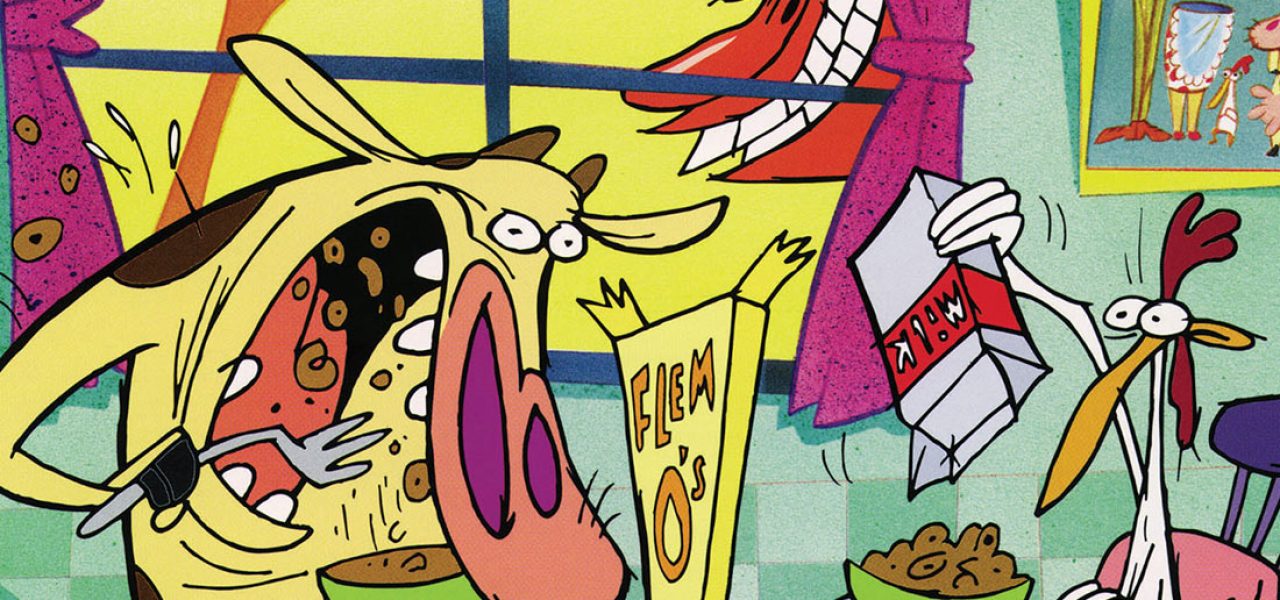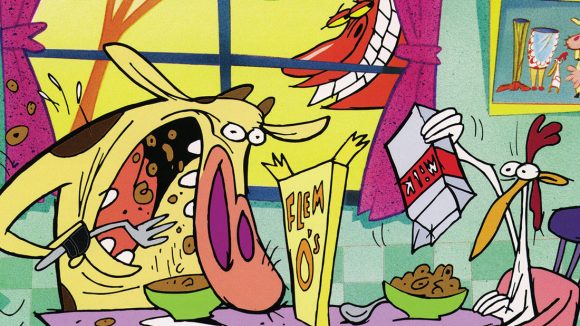

From ‘Cow & Chicken’ to ‘Open Season’: Q&A with David Feiss
Writer, animator, and director David Feiss was hired at Hanna-Barbera when he was still a teenager, after bringing his first short animated film to the job interview along with an actual 8mm projector to screen it on. Nearly forty years later he has amassed a wealth of experience on projects as diverse as The Jetsons, The Ren & Stimpy Show, his own Cow & Chicken and I Am Weasel, the ill-fated YooHoo and Friends, several shorts and feature film assignments, and more recently some of the Open Season films from Sony.
Cartoon Brew sat down with Feiss in Turin, Italy at the VIEW Conference to find out more about these key projects, including the director’s recent work on Open Season: Scared Silly, the fourth release in the franchise.
Cartoon Brew: Can we jump straight into your Cow & Chicken, which you’ve said started as bedtime stories for your daughter – how did it turn into a Cartoon Network show?
David Feiss: I think it was just a perfect storm time. Cartoon Network knew me, or, at least, Hanna-Barbera knew me. CN was the new network which was showing the Hanna-Barbera library. In 1994 they said they wanted to do original programming and they put money up to make 52 pilots. Mine was one of the pilots. Well, I had this thing, a book, I’d only created three weeks before called Cow & Chicken. They said, ‘We like that one, what story would you do?’ My book basically only introduced the characters and I had to come up with a story.
This was a book you’d made for your daughter?
David Feiss: I just made it up verbally for her, but the next morning I drew it. And then I did a story and that’s what they bought. When I was doing the story, I realized I needed something more than just Cow and Chicken. So that’s when the Red Guy came in.
He was the devil, basically.
David Feiss: Yeah, that’s right. Actually that’s another thing I was told: they said that was funny for the pilot, but you can’t do the devil in America. I didn’t really get why. It was fine for me to do the devil, but you couldn’t call him the devil.
How did you tackle Cow & Chicken from a production point of view?
David Feiss: It was a 2D animated show. Most people who directed the pilots weren’t animators. But I was an animator, so I asked if I could animate it myself. And they said, ‘Well, if you want to…’ It was a way of setting the style. I was working at the time so I did it at night, after work. It took 10 months.

Cow & Chicken and, earlier, Ren and Stimpy, which you worked on, were certainly for kids but also felt new and unique at the time. What was your assessment about who they were for?
David Feiss: They were for kids, but definitely thinking of adults. I grew up watching Rocky and Bullwinkle, which I laughed at as a kid but then laughed at later and realized they were written for adults! And it was because of Ren and Stimpy that shows like Cow & Chicken could ever be on the air. Before that, Hanna-Barbera would internally make their own show. It wasn’t like creators came in and sold their ideas. Ren and Stimpy broke that mold.
Was it hard to adapt to a certain style with Ren and Stimpy, given it was so different?
David Feiss: That was [show creator] John Kricfalusi’s style. That’s what he does. A lot of people think my style is like John’s, but my style has always been the kind of style I had on Cow & Chicken.

You worked on a re-imagining of YooHoo & Friends with the rapper Flavor Flav, but then there was a lawsuit and it was not shown in many places around the world. What happened?
David Feiss: YooHoo and Friends was made originally by a company out of Seoul in Korea and they made these little dolls. They contracted to make that 52-episode series that was made for really young children. It made no sense at all. When I was given this show, they said, ‘Can you make this something to sell?’ Well, it was not my style, but then I did think of the Woody Allen film What’s Up, Tiger Lily? where he recorded new dialogue for old picture, and I thought that could make sense.
And then I just happened to meet Flavor Flav—I lived across the street from him—and he said, ‘Hey man, I always liked Hanna-Barbera; I love cartoons, I wanna do voices,’ and I said, ‘I have a character for you’. And, in the middle of the street, he said, ‘Call my manager right now!’ And he told his manager on the phone, ‘I wanna do this!’ And that was it, and we did it. But there was a copyright lawsuit and the show only aired in a few places including Australia, the U.K. and Latin America.
How did it make you feel when it was hardly shown around the world?
David Feiss: I was bummed, knowing Flavor Flav – he wanted to do this and I didn’t have to twist his arm. He did it for hardly any money at all. The idea was that it would be worldwide and be a big thing for him. I wanted the world to see this!
Later when you went on to work as head of story on Open Season, that was obviously a cg animated film. How different was that from a technical point of view?
David Feiss: Well, drawing the story portion is the same. I still draw in 2D. I mean, I draw on a computer screen but it’s still traditional drawing. So it wasn’t even an issue on Open Season. I do think the 3D looks better. It looks more believable. Look at Zootopia – you really believe those places are real. It’s a little more engaging for people. I like it a lot. I like how my characters translate in a cg world.
One of the fun scenes you boarded in Open Season really shows off your skills—when Elliot is trying to get Boog’s attention and he is throwing rabbits against the garage window instead of say little pebbles. You boarded that scene. an you talk about how it came about?
David Feiss: Well the director Jill Culton was describing the scene of Boog in there sleeping and Elliot would throw the pebbles against the glass. And I thought, well, that’s great, but why not rabbits?
Did you just say that out loud, or did you go ahead and draw it?
David Feiss: I just did it. I knew that if I said it out loud people would go, ‘No no no.’ So it was a surprise. At the time we all worked on paper panels [and put them] up on boards. And I’d drawn this out. People told me later, they were looking at it and saying, ‘Are they rabbits hitting the glass!?’ I’d describe the scene of Elliot calling out and then you’d hear ‘Wap!’ and then ‘Wap!’ again, and then you’d cut to the shot of the rabbit outlines hitting the window, and it got big laughs. And then for the entire series, they kind of kept using these rabbits as different things—Boog would wrap himself in rabbits or he’d sleep on a bed of rabbits or there’d be a ‘rabbit fight.’ Poor rabbits.
Let’s talk about Open Season: Scared Silly – what was that experience like?
David Feiss: It was made for a real shoe-string budget. It was $5.5 million, which might seem like a lot of money, but for a feature film at Sony Pictures, that was not a lot of money. So we had to be really smart. We couldn’t do a lot of moving camera work and we could only do a minimal amount of water. We made it seem like it was an expensive movie, but it wasn’t. The film happened in a little bit of a perfect storm, too. The Sony hack happened and my bosses lost their jobs. I was still plugging along and I was kind of left alone.
The film opens with a black-and-white sequence…
David Feiss: It’s supposed to be a spooky movie, so I was thinking Young Frankenstein and monster movies, and thought it might be a different thing. And it made it a fun joke because Elliot is telling a story about the werewolf and then McSquizzy the squirrel tells him, ‘Who tells a story in black and white anyway?’
Anything you can say about what you’re doing next?
David Feiss: I’m developing an original idea of mine. These are always long shots, but that’s what I’m doing right now at Sony. Hopefully it will have the sensibilities of family films but with a little bit of my twist.

.png)